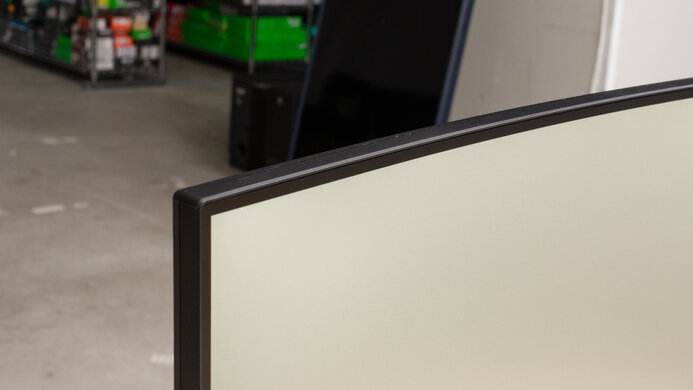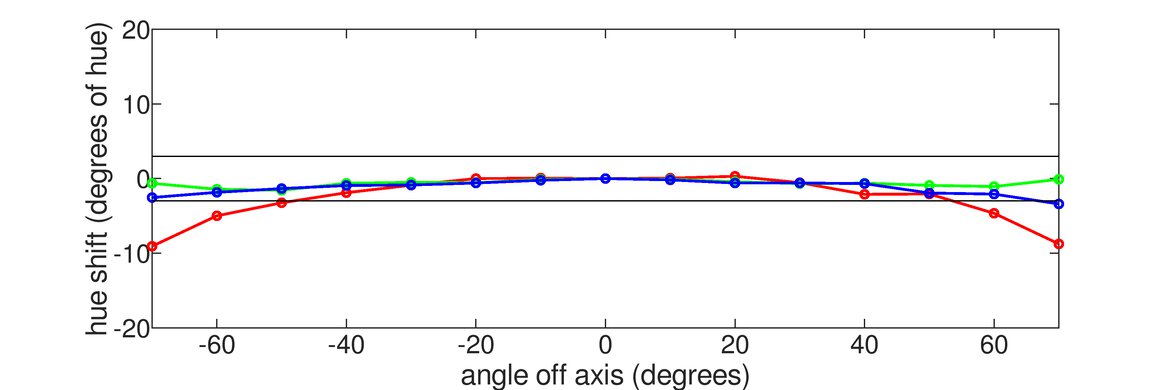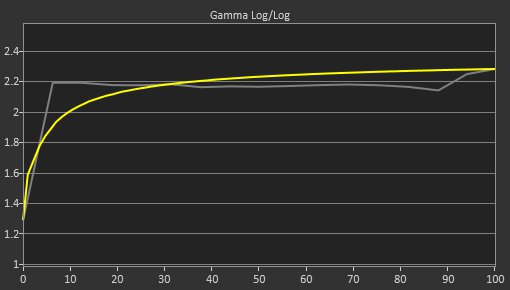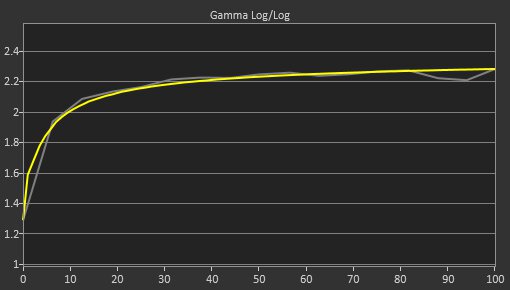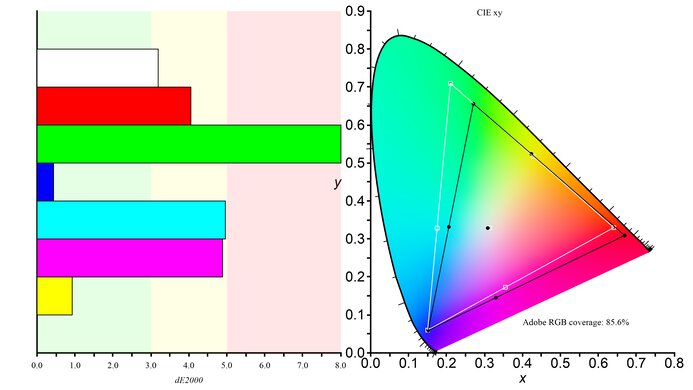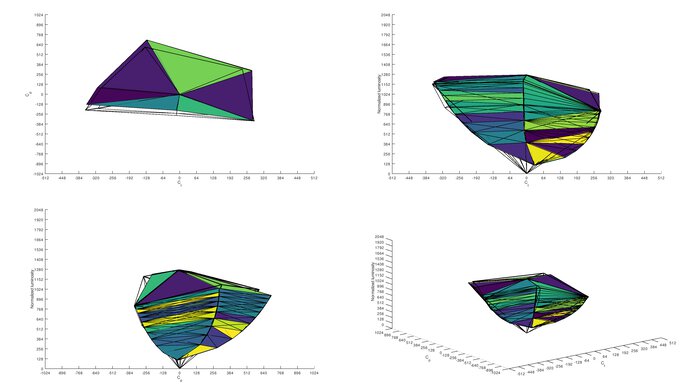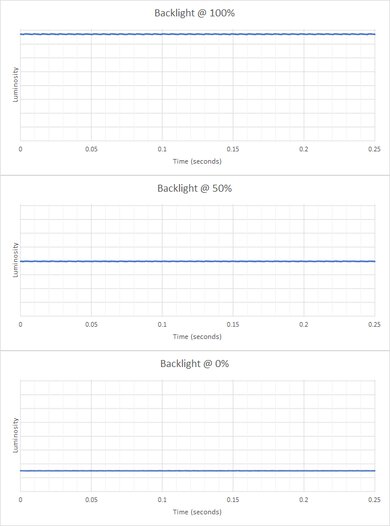The MSI Optix G27C6 is a good entry-level gaming monitor. It has a few gamer-oriented features like FreeSync variable refresh rate (VRR) support. It has a 165Hz refresh rate, which you can achieve over a DisplayPort connection, but the monitor only comes with an HDMI cable, and you're limited to 144Hz over HDMI. Input lag is very low, but sadly, motion looks blurry, and there's noticeable smearing due to its slow response time. It has a VA panel with a high contrast ratio that displays deep blacks. Unfortunately, it's not very well-rounded for other uses because it has a lower 1080p resolution, terrible ergonomics, narrow viewing angles, and it doesn't support HDR. It's also not well-built as we had trouble properly attaching the feet to the stand, but this could be a problem with our unit alone.
Our Verdict
The MSI Optix G27C6 is okay overall. It's designed for gaming and offers good performance in that regard. It has a 165Hz refresh rate with VRR support and low input lag. Sadly, the response time is slow, and motion looks blurry. It's just okay for office use or content creators because it has a less-than-ideal 1080p resolution, and since it has low pixel density, text doesn't look very sharp. It also has terrible ergonomics, so it may be hard to place it in an ideal viewing position.
- Good peak brightness.
- 165Hz refresh rate with VRR support.
- Excellent native contrast ratio.
- Terrible ergonomics.
- Slow response time results in blurry motion.
- Only comes with HDMI cable and limited to 144Hz over HDMI.
The MSI Optix G27C6 is okay for office use. It has a large 27 inch screen, so you can open windows side-by-side, but with its low resolution, text looks a bit blurry. It gets bright enough to combat glare in most settings, but it's best to avoid using it in a bright room. Sadly, it's not the best choice for sharing your screen with others because it has narrow viewing angles and terrible ergonomics.
- Large 27 inch screen.
- Good peak brightness.
- Decent reflection handling.
- Text and images aren't sharp due to lower 1080p resolution.
- Terrible ergonomics.
- Narrow viewing angles.
The MSI Optix G27C6 is good for gaming. It has features most gamers want, like a 165Hz max refresh rate, FreeSync support, and G-SYNC compatibility. Input lag is really low, but the response time is slow, resulting in blurry motion. It's a good choice for dark room gaming thanks to its high contrast ratio, but there's no local dimming feature to improve it.
- 165Hz refresh rate with VRR support.
- Very low input lag.
- Excellent native contrast ratio.
- Slow response time results in blurry motion.
- Only comes with HDMI cable and limited to 144Hz over HDMI.
The MSI Optix G27C6 is okay for watching multimedia content. The 27 inch screen helps deliver an immersive viewing experience. Its 1080p resolution may be too low for some, but it's good enough for watching some shows or movies. It has an excellent native contrast ratio to deliver deep blacks. Sadly, it has narrow viewing angles, so we don't suggest it for watching content with a few friends.
- Large 27 inch screen.
- Excellent native contrast ratio.
- Decent reflection handling.
- Text and images aren't sharp due to lower 1080p resolution.
- Terrible ergonomics.
- Narrow viewing angles.
The MSI Optix G27C6 is alright for content creators. It has a low resolution, so images don't look crisp and detailed, but the 27 inch screen allows you to open a few windows side-by-side. Unfortunately, it has narrow viewing angles, and the stand only offers tilt adjustments, so it's hard to share the screen with a coworker or client.
- Large 27 inch screen.
- Excellent native contrast ratio.
- Text and images aren't sharp due to lower 1080p resolution.
- Terrible ergonomics.
The MSI Optix G27C6 doesn't support HDR.
Check Price
Differences Between Sizes And Variants
We tested the MSI Optix G27C6 in a 27 inch size, which is the only size available for this model. There's an MSI Optix G24C6, but it has a lower 144Hz refresh rate. There are other monitors in MSI's G Series lineup, and you can see the differences between them below.
| Model | Size | Type | Resolution | Refresh Rate | Inputs | Notes |
|---|---|---|---|---|---|---|
| MSI Optix G24C6 | 24" | VA | 1080p | 144Hz | 2x HDMI 1.4 1x DisplayPort 1.2 |
|
| MSI Optix G27C4 | 27" | VA | 1080p | 165Hz | 2x HDMI 1.4 1x DisplayPort 1.2 |
|
| MSI Optix G27C5 | 27" | VA | 1080p | 165Hz | 2x HDMI 1.4 1x DisplayPort 1.2 |
|
| MSI Optix G27C6 | 27" | VA | 1080p | 165Hz |
2x HDMI 1.4 1x DisplayPort 1.2 |
|
| MSI Optix G27C6P | 27" | VA | 1080p | 165Hz | 2x HDMI 1.4 1x DisplayPort 1.2 |
Height adjustable stand |
| MSI Optix G27C7 | 27" | VA | 1080p | 165Hz | 2x HDMI 2.0 1x DisplayPort 1.4 |
If someone comes across a different type of panel, or if their MSI Optix G27C6 doesn't correspond to our review, let us know and we'll update the review. Note that some tests, like the gray uniformity, may vary between individual units.
Our unit was manufactured in December 2020, and you can see the label here.
Popular Monitor Comparisons
The MSI Optix G27C6 is a good gaming monitor, but despite its low price, there are other budget-friendly options that you can get with better performance, like the Acer Nitro XF243Y Pbmiiprx. Compared to the MSI Optix G27C5, it has a slower response time that makes motion look blurry, so it's not worth the upgrade.
Also see our recommendations for the best gaming monitors, the best 1080p monitors, and the best budget monitors.
The MSI Optix MAG273R is better overall than the MSI Optix G27C6, but they have different panel types. The MAG273R has an IPS panel with wider viewing angles, while the G27C6 is better for dark room gaming because its VA panel has a higher contrast ratio. Even though the G27C6 has a higher 165Hz refresh rate compared to 144Hz, the MAG273R has quicker response times for better motion handling. It also supports HDR, which the G27C6 doesn't, but it doesn't add much because it doesn't get bright enough to make highlights pop.
The Samsung Odyssey G3 F27G35T and the MSI Optix G27C6 are both good budget-friendly gaming monitors. They each have a VA panel with a 1080p resolution, but the MSI has a higher 165Hz refresh rate than the 144Hz on the Samsung. They're very similar in performance; they have native FreeSync support, G-SYNC compatibility, and low input lag, but their response times are slow. The Samsung is a bit more versatile for other uses because it has much better ergonomics, but the MSI gets brighter if you want to use it in a well-lit room.
The MSI Optix G27C6 is a better gaming monitor than the Samsung T55, mainly because the MSI has a higher 165Hz refresh rate compared to the Samsung's 75Hz. They each have a slow response time for gaming, so motion looks blurry. Also, each monitor has a 1080p resolution, and while the MSI is only available in a 27 inch size, the Samsung is available in 24, 27, and 32 inches, so you can get the one you prefer.
The MSI Optix G27C6 and the MSI Optix G27C5 are similar monitors with a 1080p resolution, 165Hz refresh rate, and a VA panel. There's little difference between each, but the G27C5 has a much quicker response time, resulting in smoother motion. They're built similarly, but our unit of the G27C6 has wobbly feet, although this could be an issue with our unit alone.

We buy and test more than 30 monitors each year, with units that we buy completely on our own, without any cherry-picked units or samples. We put a lot into each unbiased, straight-to-the-point review, and there's a whole process from purchasing to publishing, involving multiple teams and people. We do more than just use the monitor for a week; we use specialized and custom tools to measure various aspects with objective data-based results. We also consider multiple factors before making any recommendations, including the monitor's cost, its performance against the competition, and whether or not it's easy to find.
Test Results

The MSI Optix G27C6 is a curved monitor with a fairly simple design similar to other MSI G Series monitors. There's not much difference from the MSI Optix G27C5. It has an all-black plastic body with a touch of glossy accents on the back. Although designed with gamers in mind, it shouldn't stand out in an office environment either.
The stand consists of two wide-set feet, so there's enough space to put stuff in front. We had issues properly attaching the feet to the trunk of the stand, so there's a ton of wobble, and it's noticeable even in regular use. However, we don't know if this is an issue with our unit or a common problem.
Sadly, the ergonomics of the MSI Optix G27C6 are terrible. You can only tilt it, so it may be difficult to place it in an ideal viewing position. The Samsung Odyssey G3 F27G35T is a similar monitor that has much better ergonomics, if that's what you prefer.
The back of the MSI Optix G27C6 looks very similar to the MSI Optix G27C5, except the glossy plastic now stretches completely across the screen. The brushed plastic on top gives it a more premium look as well. Sadly, it doesn't offer any cable management.
The MSI Optix G27C6 has disappointing build quality, but it's scored so low because the feet don't attach to the stand properly, making the monitor very wobbly. It seems like the included screws aren't threaded properly as the feet remain loose no matter how much you tighten them. We don't know if this is an issue with our unit or if it's common. If you experience the same thing, let us know.
Besides that, the monitor is built with an all-plastic body that feels a bit cheap. The plastic on the back feels loose, and the bottom bezel isn't uniformly attached to the screen.
The MSI Optix G27C6 has an excellent native contrast ratio, one of the best we've seen on any monitor. It displays deep blacks when viewed in the dark, but unfortunately, there's no local dimming feature to improve it. The native contrast is much higher than the advertised 3000:1 contrast, but this can vary from unit to unit.
The MSI Optix G27C6 doesn't support local dimming. The video above is provided for reference only.
The MSI Optix G27C6's SDR peak brightness is very good, an improvement over the MSI Optix G27C5. It's higher than the advertised 250 nits, and brightness remains consistent across different content. It gets brighter with real content than it does with our test slides, so it should get bright enough to combat glare in most lighting conditions.
We tested the SDR brightness after calibration in the 'User' Picture Mode.
This monitor doesn't support HDR.
The MSI Optix G27C6 has narrow horizontal viewing angles. This is because it has a VA panel, so the image loses accuracy when viewing from the side. It's not an ideal choice for co-op gaming.
Like the horizontal viewing angles, the vertical viewing angles are narrow. It's not suggested to mount high above eye level because the image would start to look inaccurate.
The MSI Optix G27C6's gray uniformity is excellent. The edges are a bit darker, but it's not too bad, and there's no dirty screen effect in the center. Uniformity is even better in near-dark scenes. Keep in mind that uniformity can vary between units.
The MSI Optix G27C6's black uniformity is disappointing, but this can vary between units. Backlight bleed is visible along the top and bottom edges, which could be distracting in near-dark scenes. As mentioned, there's no local dimming feature to improve it.
The out-of-the-box accuracy is good, but this can vary between units. Colors and white balance are slightly off, but most people shouldn't notice this. Color temperature is on the cold side, giving the image a blueish tint. Also, gamma doesn't follow the sRGB target curve perfectly, as dark scenes are over-darkened and other scenes are too bright.
The MSI Optix G27C6's accuracy after calibration is fantastic. Colors and white balance are nearly spot-on, and the color temperature is extremely close to the 6500K target. Gamma is also improved, but some really dark and really bright scenes are still a bit too bright.
You can download our ICC profile calibration here. This is provided for reference only and shouldn't be used, as the calibration values vary per individual unit, even for the same model, due to manufacturing tolerances.
The MSI Optix G27C6 has a fantastic SDR color gamut. It has near-full coverage of the sRGB space used in most web content. If you want to use it for photo editing, you should be happy to know it has excellent coverage of the Adobe RGB color space.
The MSI Optix G27C6 doesn't support HDR. It's advertised to have 90% DCI P3 coverage, but we don't test for it because of its lack of HDR support.
This monitor doesn't support HDR.
There are some signs of image retention after displaying high-contrast static images for 10 minutes. However, it disappears quickly, and since this can vary between units, your experience may vary.
The MSI Optix G27C6's reflection handling is just decent. Even with a bit of light, there's a distracting glare that stretches across the screen, which you can see on the left side. It really struggles with intense light on it, so don't place it opposite a window.
| Overdrive Setting | Response Time Chart | Response Time Tables | Motion Blur Photo |
| Normal | Chart | Table | Photo |
| Fast | Chart | Table | Photo |
| Fastest | Chart | Table | Photo |
The response time of the MSI Optix G27C6 at its max refresh rate is just okay. With the recommended overdrive setting of 'Fastest', the total response time is slow, especially in dark scenes. Motion looks blurry and smearing is noticeable, which can be common amongst VA panel monitors.
| Overdrive Setting | Response Time Chart | Response Time Tables | Motion Blur Photo |
| Normal | Chart | Table | Photo |
| Fast | Chart | Table | Photo |
| Fastest | Chart | Table | Photo |
The response time at 60Hz is disappointing, so motion looks really blurry. We recommend using the 'Fastest' setting again because it has quicker response times than the others, but it's still slow, and there's even overshoot in some transitions. Black smearing is less visible, and there's a noticeable blur trail behind fast-moving objects.
Like with other MSI monitors we've tested, it has a Black Frame Insertion feature to try to reduce motion blur. However, it works within a narrow frequency range, and VRR can't be enabled simultaneously. Keep in mind that the BFI score is based on the flicker range and not the actual performance.
The MSI Optix G27C6 has native FreeSync support, and even though it's not officially certified by NVIDIA, G-SYNC also works. You can achieve its full refresh rate range over a DisplayPort connection. G-SYNC doesn't work over HDMI, and since it only has HDMI 1.4 support, its max refresh rate over HDMI is 144Hz. This is a bit disappointing considering the monitor only comes with an HDMI cable, so you need your own DisplayPort cable to use it to its max capabilities.
We also noticed some issues with FreeSync enabled. The VRR worked properly as there was no tearing, but there was some noticeable flickering in dark scenes. We also noticed this issue on the Samsung Odyssey G7 before a software update. Since the MSI Optix G27C6 doesn't have any accessible USB ports, it's unlikely to receive a firmware update to fix this issue. If you experience the same thing, let us know.
The input lag is extremely low. It only slightly increases with VRR or BFI enabled, which shouldn't be noticeable to most people.
Thye MSI Optix G27C6 has a large 27 inch screen, but with its 1080p resolution, pixel density is a bit low.
Sadly, there aren't many extra features on the MSI Optix G27C6, but it still has:
- Blue Light Reduction: Removes blue light to help reduce eye strain.
- Crosshair: Adds a virtual crosshair on the screen for FPS games.
- Frame Rate Counter: Displays the current frame rate of your game.
- Night Vision: Increases gamma so that you can see objects in shadows in games.
MSI advertises that it's compatible with the PS4, PS5, and Xbox (doesn't specify which one), but we don't test for console compatibility with monitors.





